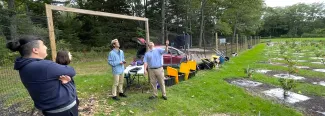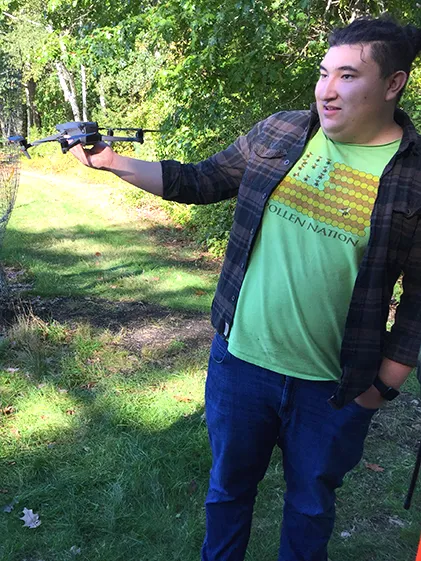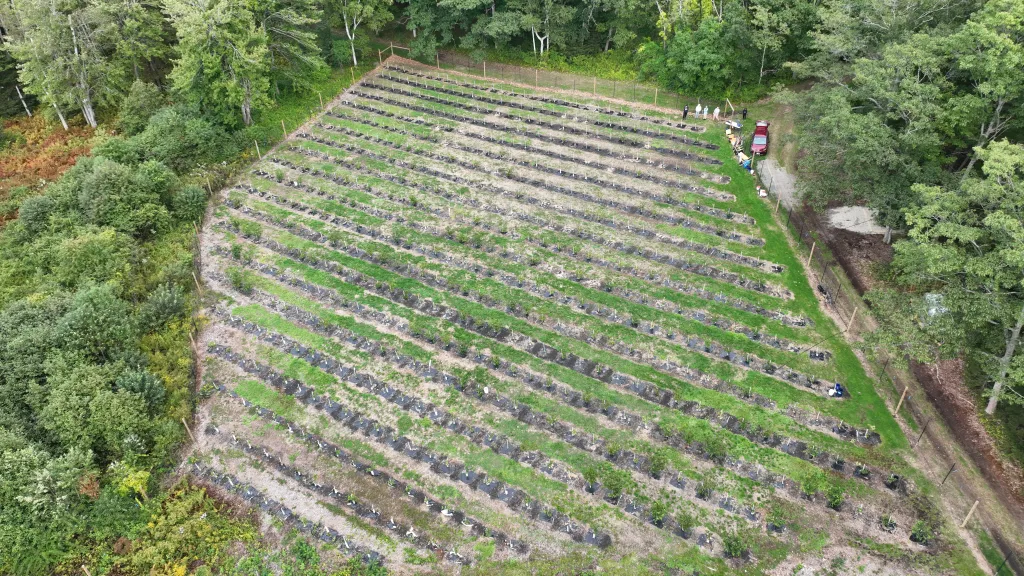
A group of students in Professor Will Kochtitzky’s Spatial Analysis class have spent much of their fall semester assisting with one of UNE’s signature research projects: the restoration of the American chestnut tree, led by Thomas Klak, Ph.D., professor of environmental studies.
Once touted as “the redwood of the East,” the American chestnut was all but destroyed during the last century by an imported fungal blight that is still killing the few remaining trees today. The blight has wiped out an estimated four billion trees.
To revitalize this keystone species, Klak has collaborated with a team of scientists to create fungal blight-tolerant chestnut seedlings by inserting a gene from wheat into them, which protects the plant from the blight. In 2021, he established New England’s first orchard of blight-tolerant seedlings planted next to a range of control chestnut seedlings in the forest of Cape Elizabeth.
As these two types of chestnut seedlings have grown up over the past two summers, Klak and his students have visually noted that they are growing at markedly different rates. So, in late summer 2022, he approached Kochtitzky to see if his GIS students could develop a biomass index for the chestnut orchard.
“Using the biomass index, we can determine how much biomass each tree has to quantify the tree growth,” said Kochtitzky, Ph.D., visiting assistant teaching professor of GIS (geographic information systems) at UNE. “This critical information will allow us to quantify the differences between the genetically modified chestnuts and traditional strains of the chestnut trees.”
To develop the biomass index, students used drones to create a digital elevation model (DEM) of the orchard — an example of the many ways GIS students engage in experiential learning opportunities.
“Getting any experience flying the drone is really exciting, and being able to work with real, important data has been really educational and fun,” said Leo Cha (Marine Sciences, ’23). “I have learned many techniques in GIS just trying to work out some of the issues that have come up with this project."

Leo Cha holds a drone used for spatial analysis.
“I’ve been in awe with the GIS students’ diligence on this vital yet laborious project,” Klak remarked. “And the students’ novel biomass index demonstrates how environmental science at UNE advances through the combined expertise that students develop among inter-connected courses.”

Prof. Thomas Klak, Ph.D., standing with a transgenic American chestnut seedling
Kochtitzky said hands-on experiences are not just fun — they are valuable learning opportunities that prepare students for work in their professional fields after graduation.
“Projects like this are important for students to gain experience doing research because it helps them see that we don’t always know the answer,” he said. “The students have had to work through many challenges and have problem-solved to overcome each of them."
"Those skills will benefit them in any career they choose, not just GIS," he added. "Of course, it is also wonderful to get them experience using technology that can directly shape their career trajectories.”
